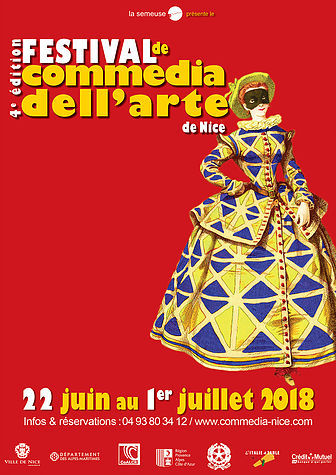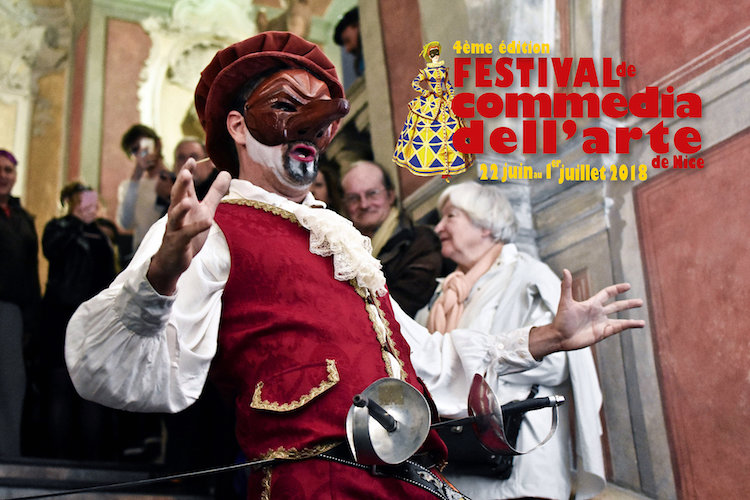When Italy’s traditional and popular mask theatre meets Shakespeare and Molière in Nice, and an American gets in the mix, comedic alchemy happens.
Making the mask of human nature fall – that is the mission of commedia dell’arte since the mid-1600s, and it has never been more pertinent than in these our troubled times. Maybe this need for unmasking is felt throughout society, and this is why it’s Niçois namesake festival has become a staple in the city’s annual agenda in just four short years since its inception. Or maybe it’s much less philosophic than that, and the Festival de Commedia dell’Arte is so popular because no one can resist the lure of theatre based on action, improv, pantomime, music, dance, acrobatic skills, and interaction with the public? Whatever the reasons, a top notch program of 13 plays, and a hands-on mask making class brings this popular arts form to life again in Frédéric Rey’s annual flagship event from June 22nd through July 1st,, 2018. And this year, for the first time, the festival will host a production in English language, performed by an American company.
Commedia is quintessentially Italian no matter how you slice and dice it, and so it is only right to open the ball with Romeo e Giulietta at the Italian consulate’s very own Teatro Garibaldi on June 22. The venerable Stivalaccio Teatro, renowned far beyond the confines of The Boot, tackle Shakespeare’s most popular play in a way that has you wonder if you should laugh or cry, or do both simultaneously. The supremely talented trio Anna De Franceschi, Michele Mori & Marco Zoppello ensure that you are in for a true treat. The play is in Italian but even for those who do not, it is still a magical experience, with some French keywords sprinkled in for linguistic help. (They are also on the playbill at the Providence on Saturday, June 23, at 9 pm, and Molière’s Le Malade Imaginaire promises to be just as hilarious.)
 Ye iconic English Bard is invited that same night at La Providence by none other than Carlo Boso. Boso is to commedia what Peter Brook is to theatre – a Living God. For his friend Frédéric Rey, Carlo descended from his Milanese Olymp to direct Les deux gentilshommes de Vérone. A first spectacular highlight of this festival, and one that you absolutely do not want to miss.
Ye iconic English Bard is invited that same night at La Providence by none other than Carlo Boso. Boso is to commedia what Peter Brook is to theatre – a Living God. For his friend Frédéric Rey, Carlo descended from his Milanese Olymp to direct Les deux gentilshommes de Vérone. A first spectacular highlight of this festival, and one that you absolutely do not want to miss.
But commedia is not exclusively Italian. To find out more about this intriguing variation of the performing arts, we go right to the source and ask Guy Spielmann, the director of the first ever English play in the programme. “In fact, the original commedia quickly spread out to the whole of Western Europe; by the end of the seventeenth century, commedia could be in French, in English, in German or even in Dutch as much as in Italian,” he explains. “What makes commedia truly original is that, initially, there was no play—a series of dialogues written by an author, with a coherent plot, structured in acts and scenes. A show began with a scenario, a summary that simply indicated what happens in sequence and which character does what… In every production, the same types (tipi) reoccurred—Pantalone, Dottore, Arlecchino, Columbine, Isabella, Capitano…—and played different characters.”
The aptly named Professor Spielmann (whose name is rooted in the German word for “actor” or “performer”) is not only a passionate theatre lover and practitioner but also a lecturer at the prestigious Georgetown University of Washington DC and a walking, talking encyclopedia on the topic. After visiting the 2017 edition of the Festival Commedia dell’Arte de Nice, he approached Frédéric Rey and suggested a contribution of his own to this year’s programme. Frédéric, also well known for his aptitude of foreign languages, quickly agreed, and it is thus that Harlequin on the Moon premiers during the 2018 festival as the first ever English language play of the festival, and based on the classic commedia archetypes:
Dottore, believing himself to be a brilliant scientist, has acquired the near-certainty that there are people on the moon; in order to be sure, he needs a powerful telescope, and in order to finance it, he is ready to marry off his daughter Eularia to the old and very rich Pantalone. Eularia, of course, would much rather marry the young and handsome Cinthio, and everything revolves on how these two could possibly be wed with Dottore’s agreement. Harlequin, in charge of crafting a clever plan, thinks that it is better to humor Dottore in his delirious visions; but he will have to imagine ever more off-the-wall tricks before a solution can be found. Multiple disguising, dance scenes and improv will ensue….
Harlequin will be playing on Saturday, June 23 at Palais Lascaris at 5 pm and on Monday, June 25 at La Providence at 8:30 pm, and it promises to be a delight.
https://youtu.be/fBw3fgdePvE
Needless to say, La Semeuse will also contribute its own production, directed by the multi-hatted and multi-talented Frédéric Rey, that has French and Italian audiences jump to standing ovations ever since it began touring a while ago. La Folle Jeunesse de Cathérine de Médicis revisits the adventures of the capricious Italian princess who marries into the stuffy French court. Two cultures, so close and yet so far apart, collide and provoke much reason for eyebrow-raising and snickering, all in a loving tribute to the first ever commedia dell’arte company founded in Padova in 1545. Mark your agendas for Sunday June 24th at 9 pm or Sunday, July 1st at 6:30 pm, both at the Centre Culturel de la Providence.
There is of course so much more to see – Marco Polo’s unforgettable voyage which was the 2017 edition’s sensation, or Molière’s Les Précieuses Ridicules for those who just have to have their fix of classics. Theatre, music, mask making, and even puppets…. There is something for everyone, from age 7 to 97, and it’s not just limited to La Providence or La Semeuse, but will also go to Théâtre Francis Gag, and across town and its hinterland (Bon Voyage, Las Planas, Condamine, Carros and Aribeau sur Siagne). The easiest way to get a good sense of the rich programme is to check out the schedule.
Commedia dell’arte is fun and physical rather than text fetishism. You don’t even need to understand a foreign language to enjoy it. Commedia breaks down barriers, linguistic and social. More than any other art form, it holds a mirror up to society, forcing it to have a good look at the masks it wears. Like in real life, everyone plays an archetypical role, from wise man to the teller of truth or the wicked character. Some of us have the courage to drop our masks, others hang on to it for fear of being discovered, unveiled, naked. It was no coincidence that commedia and the writers who would become timeless staples of European literature appeared and became popular roughly at the same time. Like Shakespeare and Molière, commedia has had its cycles but while it may have been considered old-fashioned at one time or another, it never went out of style or of substance, just as truth and justice do not. It always knew how to reinvent itself and come back. From Charlie Chaplin to Louis de Funès or Rowan Atkinson, they all master lazzi, the stock comedic routines that are traditionally associated with commedia dell’arte. And more than that – commedia keeps reminding us time and again that it’s all just a play. That is the secret to its longevity and success, and we thank people like Frédéric Rey, Carlo Boso or Guy Spielmann for being the holders of the mirror of truth in today’s society.
Tickets may be reserved online.
![]()
All images courtesy (and used with express permission of) Festival Commedia dell’Arte de Nice



Leave a Reply